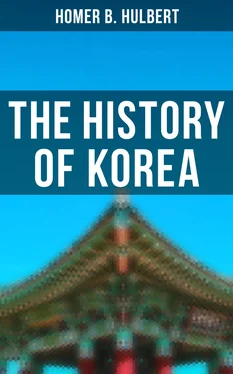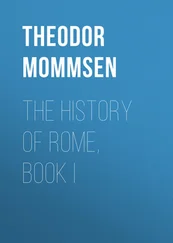Such was the miserable end of Wi-man’s treachery. He had cheated Ki-jun out of his kingdom which had lasted almost a thousand years, while the one founded by himself lasted only eighty-eight. It fell in the thirty-fourth year of the Han Emperor Wu-ti, in the year 106 B.C.
Upon the downfall of Wi-man’s kingdom, the country was divided by the Chinese into four provinces called respectively Nang-nang, Im-dun, Hyŭn-do and Chin-bŭn. The first of these, Nang-nang, is supposed to have covered that portion of Korea now included in the three provinces of P‘yung-an, Whang-hă and Kyŭng-geui. Im-dun, so far as we can learn, was located about as the present province of Kang-wŭn, but it may have exceeded these limits. Hyŭn-do was about coterminous with the present province of Ham-gyŭng in the northeast. Chin-bŭn lay beyond the Yalu River but its limits can hardly be guessed at. It may have stretched to the Liao River or beyond. It is exceedingly doubtful whether the conquerors themselves had any definite idea of the shape or extent of these four provinces. Twenty-five years later, in the fifth year of Emperor Chao-ti 81 B.C. a change in administration was made. Chin-bŭn and Hyŭn-do were united to form a new province called P’yung-ju, while Im-dun and Nang-nang were thrown together to form Tong-bu. In this form the country remained until the founding of Ko-gu-ryŭ in the twelfth year of Emperor Yuan-ti, 36 B.C.
It is here a fitting place to pause and ask what was the nature of these wild tribes that hung upon the flanks of civilization and, like the North American Indians, were friendly one day and on the war-path the next. Very little can be gleaned from purely Korean sources, but a Chinese work entitled the Mun-hön T’ong-go deals with them in some detail, and while there is much that is quite fantastic and absurd the main points tally so well with the little that Korean records say, that in their essential features they are probably as nearly correct as anything we are likely to find in regard to these aborigines (shall we say) of north-eastern Asia.
The wild tribes … the “Nine Tribes” apocryphal. … Ye-mak … position … history … customs. … Ye and Mak perhaps two. … Ok-jo … position … history … customs. … North Ok-jo. … Eum-nu … position … customs … the western tribes … the Mal-gal group … position … customs … other border tribes.
As we have already seen, tradition gives us nine original wild tribes in the north named respectively the Kyŭn, Pang, Whang, Păk, Chŭk, Hyŭn, P’ung, Yang, and U. These we are told occupied the peninsula in the very earliest times. But little credence can be placed in this enumeration, for when it comes to the narration of events we find that these tribes are largely ignored and numerous other names are introduced. The tradition is that they lived in Yang-gok, “The Place of the Rising Sun.” In the days of Emperor T’ai-k’an of the Hsia dynasty, 2188 B.C. the wild tribes of the east revolted. In the days of Emperor Wu-wang, 1122 B.C. it is said that representatives from several of the wild tribes came to China bringing rude musical instruments and performing their queer dances. The Whe-i was another of the tribes, for we are told that the brothers of Emperor Wu-wang fled thither but were pursued and killed. Another tribe, the So-i, proclaimed their independence of China but were utterly destroyed by this same monarch.
It is probable that all these tribes occupied the territory north of the Yalu River and the Ever-white Mountains. Certain it is that these names never occur in the pages of Korean history proper. Doubtless there was more or less intermixture and it is more than possible that their blood runs in the veins of Koreans today, but of this we cannot be certain.
We must call attention to one more purely Chinese notice of early Korea because it contains perhaps the earliest mention of the word Cho-sŭn. It is said that in Cho-sŭn three rivers, the Chŭn-su, Yŭl-su, and San-su, unite to form the Yŭl-su, which flows by (or through) Nang-nang. This corresponds somewhat with the description of the Yalu River.
We now come to the wild tribes actually resident in the peninsula and whose existence can hardly be questioned, whatever may be said about the details here given.
We begin with the tribe called Ye-măk, about which there are full notices both in Chinese and Korean records. The Chinese accounts deal with it as a single tribe but the Korean accounts, which are more exact, tell us that Ye and Mak were two separate “kingdoms.” In all probability they were of the same stock but separate in government.
Ye-guk ( guk meaning kingdom) is called by some Ye-wi-guk. It is also know as Ch’ŭl. It was situated directly north of the kingdom of Sil-la, which was practically the present province of Kyŭng-sang, so its boundary must have been the same as that of the present Kang-wŭn Province. On the north was Ok-jŭ, on the east the Great Sea, and on the west Nang-nang. We may say then that Ye-guk comprised the greater portion of what is now Kang-wŭn Province. To this day the ruins of its capital may be seen to the east of the town of Kang-neung. In the palmy days of Ye-guk its capital was called Tong-i and later, when overcome by Sil-la, a royal seal was unearthed there and Hă-wang the king of Sil-la adopted it as his royal seal. After this town was incorporated into Sil-la it was known as Myŭng-ju.
In the days of the Emperor Mu-je, 140 B.C., the king of Ye-guk was Nam-nyŭ. He revolted from Wi-man’s rule and, taking a great number of his people, estimated, fantastically of course, at 380,000, removed to Liao-tung, where the Emperor gave him a site for a settlement at Chang-hă-gun. Some accounts say that this colony lasted three years. Others say that after two years it revolted and was destroyed by the Emperor. There are indications that the remnant joined the kingdom of Pu-yŭ in the north-east for, according to one writer, the seal of Pu-yŭ contained the words “Seal of the King of Ye” and it was reported that the aged men of Pu-yŭused to say that in the days of the Han dynasty they were fugitives. There was also in Pu-yŭ a fortress called the “Ye Fortress.” From this some argue that Nam-nyŭ was not a man of the east but of the north. Indeed it is difficult to see how he could have taken so many people so far especially across an enemy’s country.
When the Chinese took the whole northern part of Korea, the Ye country was incorporated into the province of Im-dun and in the time of the Emperor Kwang-mu the governor of the province resided at Kang-neung. The Emperor received an annual tribute of grass-cloth, fruit and horses.
The people of Ye-guk were simple and credulous, and not naturally inclined to warlike pursuits. They were modest and unassuming, nor were they fond of jewels or finery. Their peaceful disposition made them an easy prey to their neighbors who frequently harassed them. In later times both Ko-gu-ryŭ and Sil-la used Ye-guk soldiers in part in effecting their conquests. People of the same family name did not intermarry. If a person died of disease his house was deserted and the family found a new place of abode. We infer from this that their houses were of a very poor quality and easily built; probably little more than a rude thatch covering a slight excavation in a hill-side. The use of hemp was known as was also that of silk, though this was probably at a much later date. Cotton was also grown and woven. By observing the stars they believed they could foretell a famine; from which we infer that they were mainly an agricultural people. In the tenth moon they worshipped the heavens, during which ceremony they drank, sang and danced. They also worshipped the “Tiger Spirit.” Robbery was punished by fining the offender a horse or a cow. In fighting they used spears as long as three men and not infrequently several men wielded the same spear together. They fought entirely on foot. The celebrated Nang-nang bows were in reality of Ye-guk make and were cut out of pak-tal wood. The country was infested with leopards. The horses were so small that mounted men could ride under the branches of the fruit trees without difficulty. They sold colored fish skins to the Chinese, the fish being taken from the eastern sea.
Читать дальше









